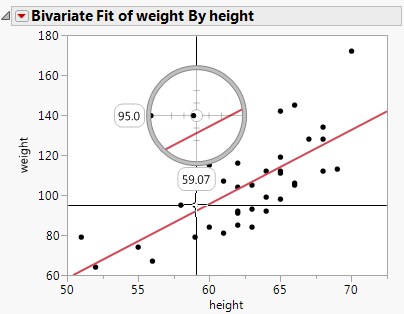Display Coordinates and Temporary Reference Lines in Graphs
You can measure points and distances in JMP graphs or easily find the exact value, or coordinates, of points and distances on plots and graphs.
The Crosshair Tool
To find exact values or coordinates, click the crosshairs tool (![]() ) and click and hold anywhere on a graph. The coordinate values appear where the crosshairs intersect the vertical and horizontal axis as you drag the crosshairs within a plot.
) and click and hold anywhere on a graph. The coordinate values appear where the crosshairs intersect the vertical and horizontal axis as you drag the crosshairs within a plot.
Figure 9.36 Using the Crosshairs Tool
On a fitted line or curve, the crosshairs identify the response value for any predicted value. On a ternary plot, this tool displays triangular crosshair lines.
The Ruler Tool
To measure the approximate distance between two values or coordinates in a graph, use the ruler tool (![]() ). Click the ruler tool, click and hold anywhere on the graph, and drag the cursor to the second point to which you want to measure the distance. The distance values appear in a display box at the end of the ruler. The box displays three values:
). Click the ruler tool, click and hold anywhere on the graph, and drag the cursor to the second point to which you want to measure the distance. The distance values appear in a display box at the end of the ruler. The box displays three values:
• the direct distance between the two points
• the change in x as dx
• the change in y as dy
Figure 9.37 Using the Ruler tool
On graphs whose values are the same data type, the ruler is displayed as a straight line between the point where you first clicked and the current location of the cursor. For graphs whose values are different data types, such as graphs that feature nominal variables and continuous variables, the ruler is displayed instead as a horizontal line and a vertical line. See Figure 9.38 for an example.
Date Variables
The ruler tool displays the distance between date variables in the format day:hour:minute:second.
In the following example, the X axis represents a date variable. By using the ruler tool to measure between one point of the low group to another coordinate in the higher group, notice that the difference between the two chosen coordinates is 3,685 days, 9 hours, 45 minutes, and 3 seconds.
Figure 9.38 Approximating the Difference between Two Date Variables
Nominal Values
Graphs that use a nominal variable for either axis treat each nominal value as 1 unit of measurement. In the following figure, the ruler measures the distance from the value Fuel Oil #2 to the value Natural Gas, showing the distance as 6 units.
Figure 9.39 Measuring the Distance Between Nominal Variables



